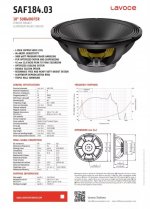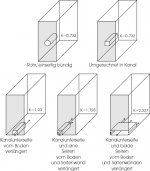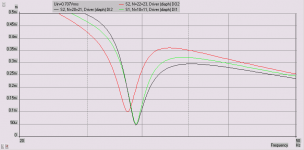Looking to design and build ported isobaric subs with 18" Lavoce SAF184.03 drivers. I was planning on configuring the drivers cone to cone with the magnet facing out, having the drivers recessed into the enclosure front with a grille to hide all of it. The ports will either be exposed to the floor or front depending on what is better at controlling potential port resonances. This may become an issue having a smaller than usual ported enclosure together with a relatively low tuning frequency (need for longer ports).
The driver spec sheet is attached below. I'm trying to get the best / lowest distortion performance, so I'm open to suggestions regarding enclosure design. The main goal with the isobaric design was to reduce the enclosure size to a practical extent while not sacrificing low end extension (-3 dB cutoff closer to 30 Hz). I wanted to keep each sub under 30" height, 20" width and 24" depth. I have a choice of running the subs with a QSC GXD8 or 700 watt Speaker Power plate amps. The QSC does about 1200 watts @ 4 ohms/ch.
These subs will end up weighing a TON with 2 large ferrite magnet drivers in each. The design is mainly meant to augment sub 100 hz low end, focusing on musicality first and foremost. The port(s) will need to be large enough in cross section to avoid compression and noise, but small enough to practically fit length wise.
The driver spec sheet is attached below. I'm trying to get the best / lowest distortion performance, so I'm open to suggestions regarding enclosure design. The main goal with the isobaric design was to reduce the enclosure size to a practical extent while not sacrificing low end extension (-3 dB cutoff closer to 30 Hz). I wanted to keep each sub under 30" height, 20" width and 24" depth. I have a choice of running the subs with a QSC GXD8 or 700 watt Speaker Power plate amps. The QSC does about 1200 watts @ 4 ohms/ch.
These subs will end up weighing a TON with 2 large ferrite magnet drivers in each. The design is mainly meant to augment sub 100 hz low end, focusing on musicality first and foremost. The port(s) will need to be large enough in cross section to avoid compression and noise, but small enough to practically fit length wise.
Attachments
Isobarik brings you (approximately) half the box size of 1 woofer.
I would either choose a single driver that fits the box volume you can afford, but AFAIC 2 woofers are best used push-push to dramatically lower reaction force energy getting into the enclosure, dramatically reducing box load. They will also not “walk”. And twice the output (or more). But 4 x bigger than the same drivers isobarik.
So unless you are already sitting on the woofers and can only afford the small box volume...
dave
I would either choose a single driver that fits the box volume you can afford, but AFAIC 2 woofers are best used push-push to dramatically lower reaction force energy getting into the enclosure, dramatically reducing box load. They will also not “walk”. And twice the output (or more). But 4 x bigger than the same drivers isobarik.
So unless you are already sitting on the woofers and can only afford the small box volume...
dave
Sometimes can use Triangle ports in all 4 corners.
2 walls shared. so correction factor is higher.
port Efficiency is lower.
Hence Triangle ports sharing 2 walls
or slot ports sharing 3 walls
are somewhat common to use.
to try and reduce needed port length.
and fit into smaller area.
port efficiency is low. so same tuning
but shorter ports.
2 walls shared. so correction factor is higher.
port Efficiency is lower.
Hence Triangle ports sharing 2 walls
or slot ports sharing 3 walls
are somewhat common to use.
to try and reduce needed port length.
and fit into smaller area.
port efficiency is low. so same tuning
but shorter ports.
Attachments
@planet10 - I already have drivers since they sounded good enough to buy again after using them once before on another project.
I like the idea of lowering THD via push pull configuration, which was something I tried before with good success. The push pull isobaric would bring the suggested cab size down to 4 cu ft (halved from 8 cu ft) for a tuning frequency of 33 hz and 95 dB(@2.83V/4 ohms) sensitivity. The only downside is weight and 1 cu ft wasted extra space from recessing the drivers.
The design also protects a little from excess infrasonic junk getting thought thanks to lower driver suspension compliance and not needing as aggressive of HP filter for running analog sources ie turntable "rumble". I don't like what HP filters do to the low end, even when they're mildly applied. It ruins the attack and low end slam to my ears. I avoid it when I can, which for home use won't be as much of an issue. If this were long stroke, higher compliance acoustic suspension setup (which i prefer), it would require a substantial HP to protect the drivers, plus it wouldn't be as efficient. I can still plug the ports and EQ it a bit to extend the LF.
I like the idea of lowering THD via push pull configuration, which was something I tried before with good success. The push pull isobaric would bring the suggested cab size down to 4 cu ft (halved from 8 cu ft) for a tuning frequency of 33 hz and 95 dB(@2.83V/4 ohms) sensitivity. The only downside is weight and 1 cu ft wasted extra space from recessing the drivers.
The design also protects a little from excess infrasonic junk getting thought thanks to lower driver suspension compliance and not needing as aggressive of HP filter for running analog sources ie turntable "rumble". I don't like what HP filters do to the low end, even when they're mildly applied. It ruins the attack and low end slam to my ears. I avoid it when I can, which for home use won't be as much of an issue. If this were long stroke, higher compliance acoustic suspension setup (which i prefer), it would require a substantial HP to protect the drivers, plus it wouldn't be as efficient. I can still plug the ports and EQ it a bit to extend the LF.
@WhiteDragon - thanks for the suggestions. I wanted to use round ports for tuning simplicity after enclosures were built. I've tried triangle corner ports before and didn't like how they appeared to make the box standing wave resonances worse. General accepted ways to deal with this are by placing ports at high pressure zones in the box. Problem is that a short port placed right next to the driver will allow more midrange to leak and cause port resonance issues by itself.
I also usually try to make ports symmetrical to even the dynamic cone surface loading for less rocking mode potential. Its a real issue in higher powered subs and I've seen it cause some weird issues if the problems stack up against you. I usually try to use the shortest port possible with the largest surface area to avoid resonance issues and minimize port losses.
I also usually try to make ports symmetrical to even the dynamic cone surface loading for less rocking mode potential. Its a real issue in higher powered subs and I've seen it cause some weird issues if the problems stack up against you. I usually try to use the shortest port possible with the largest surface area to avoid resonance issues and minimize port losses.
Push-pull reduces 2nd exaserbating third. Only worthwhile if the woofers are cheap.
BIG box.
dave
BIG box.
dave
Are we modeling the same driver?
I like the look of 100 litres (1 driver), so isobarik net 50 litres. Add 28 litres overhead and there is little point. If you can afford 213 llitres, i’d go push push.
Alignments with 825 litres (1 driver) look poor (i am being kind). Even half that.
dave
I like the look of 100 litres (1 driver), so isobarik net 50 litres. Add 28 litres overhead and there is little point. If you can afford 213 llitres, i’d go push push.
Alignments with 825 litres (1 driver) look poor (i am being kind). Even half that.
dave
I couldnt agree more.@WhiteDragon - thanks for the suggestions. I wanted to use round ports for tuning simplicity after enclosures were built. I've tried triangle corner ports before and didn't like how they appeared to make the box standing wave resonances worse. General accepted ways to deal with this are by placing ports at high pressure zones in the box. Problem is that a short port placed right next to the driver will allow more midrange to leak and cause port resonance issues by itself.
I also usually try to make ports symmetrical to even the dynamic cone surface loading for less rocking mode potential. Its a real issue in higher powered subs and I've seen it cause some weird issues if the problems stack up against you. I usually try to use the shortest port possible with the largest surface area to avoid resonance issues and minimize port losses.
I like symmetrical placed round ports as well.
Even more so with 18" drivers
Did quick sim of the driver
seems to like 4,5 to 5 cubic feet for single driver.
tuned around 30 ish Hz
For home use the efficiency was great.
never thought of doing isobaric with
Larger Live audio drivers.
should be interesting project
I'm going off the Lavoce recommendations from one of their own ported cab designs and my own experience with single driver in 220 liters tuned to 32 hz - it sounded REALLY good for a big ported box. Tight, clean and full. I couldn't bottom the driver with 800W running it from 30hz on up. It was impressive for a single pro 18 in a huge box. Its an impressive driver compared to 18s costing way over twice the price.Are we modeling the same driver?
I like the look of 100 litres (1 driver), so isobarik net 50 litres. Add 28 litres overhead and there is little point. If you can afford 213 llitres, i’d go push push.
Alignments with 825 litres (1 driver) look poor (i am being kind). Even half that.
dave
A pair in push/pull iso config of 110 ltrs will be IMO very good, but thats basing it off the experience with a single 18" in 220 liters.
Best make it sealed, not ported then....focusing on musicality first and foremost.
Thats why I always leave the option to run it sealed with EQ. Ported can be good if the planets align in your favor lol.
By that I mean Fs=Fb , Qts=.393 , which is the only ported alignment that sounds good to me if you can get Fb low enough to start with ie. under 30 Hz, so it acts like a huge lossy sealed box with both impedance humps being under 50hz.
Try and avoid using isobaric configuration in a ported enclosure. You won't get the same excursion-limited SPL as you would with a single driver, due to the enclosure resonance changing the effective rear enclosure volume.
See the attached graph, showing excursion.
The red line is the excursion of the outer driver of a clamshell pair.
The black line is the excursion of the inner driver.
The green line is the excursion of a single driver with T-S specs equal to the combined clamshell pair.
Most of the time, the volume of the rear enclosure is much larger than the volume of the space in the clamshell, so the two drivers move almost together.
But at port resonance, the back-pressure of the enclosure resonance has the same effect as making the enclosure much smaller, and the ratio of the two volumes becomes smaller. The volume of the clamshell space becomes significant.
See the attached graph, showing excursion.
The red line is the excursion of the outer driver of a clamshell pair.
The black line is the excursion of the inner driver.
The green line is the excursion of a single driver with T-S specs equal to the combined clamshell pair.
Most of the time, the volume of the rear enclosure is much larger than the volume of the space in the clamshell, so the two drivers move almost together.
But at port resonance, the back-pressure of the enclosure resonance has the same effect as making the enclosure much smaller, and the ratio of the two volumes becomes smaller. The volume of the clamshell space becomes significant.
Attachments
I have just simulated with WinISD the LaVoce SAF184.03 in BR, once one driver in 220 liters, tuned to 30 Hz, and once two drivers in Isobaric arrangement in 110 liters, also tuned to 30 Hz.
To ensure that the flow velocity in the port does not exceed 20 m/s when Xmax is reached, I chose the cross-sectional area of the port to be 350 cm².
While using one SAF184.03 in 220 liters predicts a port length of just under 40 cm, which is easy to handle, using two SAF184.03 in 110 liters in an isobaric arrangement already results in a port length of 90 cm.
This is always a problem when small enclosures are to be tuned low.
What I also find problematic is the recessed mounting of the two face-to-face mounted drivers. Quite possible that certain undesirable bandpass effects occur.
Many greetings,
Michael
To ensure that the flow velocity in the port does not exceed 20 m/s when Xmax is reached, I chose the cross-sectional area of the port to be 350 cm².
While using one SAF184.03 in 220 liters predicts a port length of just under 40 cm, which is easy to handle, using two SAF184.03 in 110 liters in an isobaric arrangement already results in a port length of 90 cm.
This is always a problem when small enclosures are to be tuned low.
What I also find problematic is the recessed mounting of the two face-to-face mounted drivers. Quite possible that certain undesirable bandpass effects occur.
Many greetings,
Michael
Those are both good bits of info. I'm aware of the iso coupling volume issue. Thats why I only do cone-cone config on iso designs, but it can still cause issues ie resonances, etc. Added mass will offset the problem slightly but is hard to predict with larger drivers. Then there's the issue of outer driver mechanical noise. Coupling volume has to be as small as possible and parallel wired for equal current drive on both drivers (a given if you want 4 ohms from 2 drivers). The parallel drive is what offsets the delta Fb issues described above. There is also the issue with the coupling volume resonating out of pass band, but thats more complicated of am issue.
Port length is a concern at that small volumr.tuned so low. The compromise is a smaller port but it may not be possible to decrease size to obtain acceptably low port velocity. Decisions, decisions...
Port length is a concern at that small volumr.tuned so low. The compromise is a smaller port but it may not be possible to decrease size to obtain acceptably low port velocity. Decisions, decisions...
I must also say that the port lengths predicted in WinISD often do not turn out exactly like that in practice.
I would always build a prototype to get closer to the correct tuning, for example by impedance measurements during the variation of the port length. Often the port length is then somewhat smaller than predicted in the simulation.
However, the port length tends to remain large with the isobaric arrangement.
The problem with such large port lengths is that the first port resonance can come so close to the transmission range of even subwoofers that it may no longer be reliably filtered away.
You can then either use passive radiators instead of a port, or try to eliminate the first port resonance with an absorber mounted to half the length of the port, e.g. as I sketched it here once with MS Paint:

deepl.com offers a good translation-service. Instead of the letter "ä" use "ae" and instead of "ß" "ss". 😎
Many Greetings,
Michael
I would always build a prototype to get closer to the correct tuning, for example by impedance measurements during the variation of the port length. Often the port length is then somewhat smaller than predicted in the simulation.
However, the port length tends to remain large with the isobaric arrangement.
The problem with such large port lengths is that the first port resonance can come so close to the transmission range of even subwoofers that it may no longer be reliably filtered away.
You can then either use passive radiators instead of a port, or try to eliminate the first port resonance with an absorber mounted to half the length of the port, e.g. as I sketched it here once with MS Paint:
deepl.com offers a good translation-service. Instead of the letter "ä" use "ae" and instead of "ß" "ss". 😎
Many Greetings,
Michael
Last edited:
I really never needed an absorber before, but it does look like this configuration may need one. Im also going to use different drivers, now that I was able to obtain 2 more of the 18PZB100s I originally wanted to use. The Lavoce aren't as clean in the upper pass band and have a higher Q. I like the way these B&C sound in a large sealed box, so they may work better in an iso config, avoiding pitfalls of ported design.
- Home
- Loudspeakers
- Subwoofers
- Isobaric design using Lavoce SAF184.03


